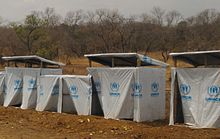Methods

To address the problem of public health and the spread of dangerous diseases that come as a result of lack of sanitation and open defecation, humanitarian actors focus on the construction of, for example, pit latrines and the implementation of hygiene promotion programs.
The supply of drinking water during an emergency in an urban-setting has been improved by the introduction of standardised, rapid deployment kits. Alternatively, germ-infected water can be sanitized by adding disinfectants, boiling and/or filtering. If the water supply contains toxic chemicals it cannot be made safe to drink.
In the immediate emergency phase, the focus is on managing open defecation, and toilet technologies might include very basic trench latrines, pit latrines, bucket toilets, container-based toilets, chemical toilets. For short-term emergencies there should be an approximate of 1 latrine or toilet for every 50 people, and work should be done with the goal of eventually reducing this amount to 20 people per latrine/toilet if possible. The short term phase might also involve technologies such as urine-diverting dry toilets, septic tanks, decentralized wastewater systems.
In urban emergencies, the main focus is usually on a quick rehabilitation and extension of existing services such as sewer-lines and waste-water treatment plants. This can also include the installation of sewerage pumping stations to improve or extend services.
The creation of provisional hand washing stations or the distribution of hand sanitizer (that contains 60% of alcohol or more) are put into practice so that people keep their hands clean and thus eliminate the propagation of germs.
Information on health care can be provided to the affected population in their respective languages, including instructions on how to use latrines efficiently. Further efforts can be made to help educate individuals who are not able to read the health communication materials.
Standardsedit
The handbook by Sphere on "Humanitarian Charter and Minimum Standards in Humanitarian Response" describes minimum standards in four "key response sectors" in humanitarian response situations. This places "Water Supply, Sanitation and Hygiene Promotion" (WASH) alongside the other response sectors which are: Food security and nutrition, shelter and settlement and health.:5 Within the "Water supply, sanitation, and hygiene promotion standards" the handbook describes standards in the following areas: Hygiene promotion, water supply, excreta management, vector control, solid waste management and WASH in disease outbreaks and healthcare settings.:91
With regards to excreta management, standards relate to: "(1) Environment free from human excreta, (2) Access to and use of toilets, (3) Management and maintenance of excreta collection, transport, disposal and treatment" (fecal sludge management).:90
Some key indicators include:
- "Ratio of shared toilets": Minimum 1 per 20 people:114
- "Distance between dwelling and shared toilet": Maximum 50 meters:114
- "Number of handwashing stations at healthcare facilities": Minimum one station for every ten inpatients:134
Comments
Post a Comment